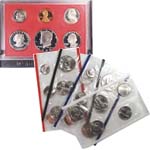"Creme de la Creme" U.S. Proof Sets and All-Inclusive Mint Sets
by John Devitt

Proof coins are the finest-quality specimens produced by the U.S. Mint. They're painstakingly created from highly polished, immaculately clean dies, which are again carefully cleaned and polished after as few as 15 strikes and soon replaced before the slightest imperfection can appear. Proof coin blanks are also individually polished to attain a stunning mirror-like finish. Each is then hand-fed into the minting press and struck at least two times to produce far more relief and sharpness than regular circulation coins can hope to show. Since the late 1970's U.S. proof dies have been treated with special chemicals to give engravings an elegant frosted effect, which contrasts beautifully with the blazing mirror look of backgrounds. Similarly frosted U.S. proof coins were produced prior to 1936 (sometimes by sand-blasting engravings on dies) and released as individual denominations to collectors. Many if not most of these earlier proofs today command thousands of dollars each, when they can be found.
The U.S. Proof SET Tradition Didn't Begin Until 1936.
The first U.S. proof sets (containing exquisite proof specimens of all denominations of the date, generally cent through half dollar) emerged in 1936. Sold directly to collectors at premium prices, they did not quickly catch on with collectors during the Depression years and their early mintages were so low that today they sell in four figures. Such sets were suspended in 1942 during World War II and not renewed throughout the postwar 1940s. In 1950 U.S. 5-coin proof sets were again issued and their mintages gradually ascended, reaching their peak in the 1970s and 1980s. Even with higher mintages, the production process remained as exacting and uncompromising as before. With a great increase in demand, proof sets that had formerly only been created by the principal Philadelphia Mint became the exclusive province of the San Francisco Mint in 1968 (later, some individual commemorative issues have been struck at the West Point Mint). As the San Francisco Mint tooled up for its proof coin minting mission, no U.S. proof sets were issued in the years 1965-1967; instead, the U.S Mint released a "hybrid" form of Special Mint Sets, which were a step above regular Brilliant Uncirculated mint set quality, but less than the distinction of proof sets. The San Francisco Mint introduced clear plastic cases for proof sets in 1968, which protect as they display the spectacular beauty of the proof coins.
In 1983 the U.S. Mint began to issue lower-mintage Prestige Proof Sets, including commemorative silver dollar proofs for the date, in addition to regular 5-coin or 6-coin proof sets. In 1992 Silver Premier Sets became another option for the proof set collector. Beginning in 1999, the size of regular proof sets increased with the special Statehood quarters issued each year through 2009 and other special additions of nickels and cents.
U.S. Mint Sets Contain Many More Coins.
Much larger U.S. mint sets were first released in 1947, each containing perfect Brilliant Uncirculated specimens of every circulation issue for the year (each coin denomination struck by the no-mintmark or later "P" Philadelphia Mint, "D" Denver Mint and sometimes "S" San Francisco Mint. The coins are protectively contained in see-through plastic packs, with the issuing mint's medal generally included in its pack. Until 1999, U.S P-D mint sets contained ten coins and P-D-S sets 11-13 coins (in 1996 there was a P-D-W set with a West Point dime). But the addition of Statehood quarters and other special circulation issues has expanded the 1999-2008 U.S. to 18-28 coins each. Since 2005, U.S. mint sets have boasted a special satin finish rather than the former BU look.
Shop With Confidence. At ICCoin, We Stand Behind Each And Every Item We Sell.
